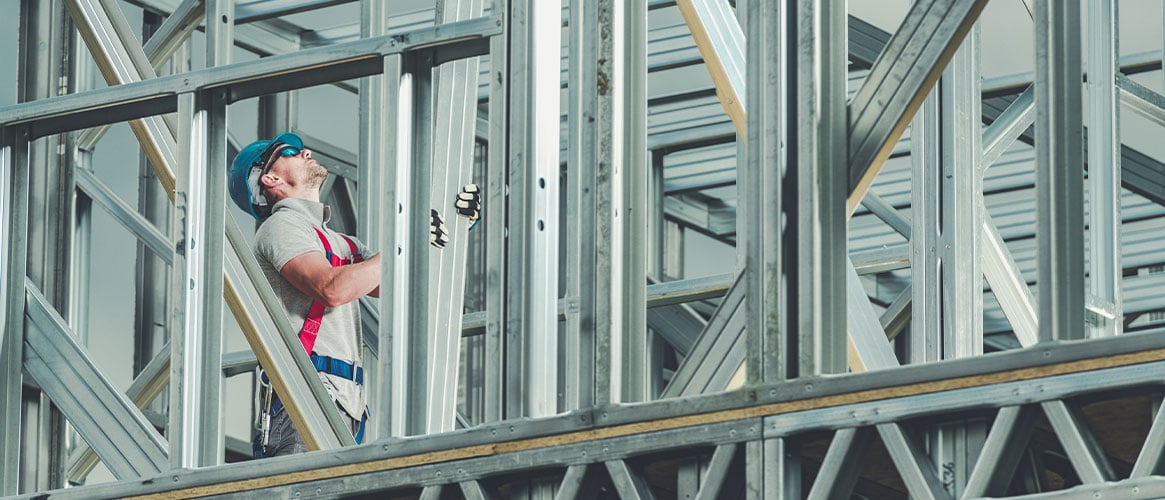Light gage steel framing is used in the construction of both residential and commercial buildings. And, it’s use has become more popular lately as an alternative to wood when framing the inside of buildings such as offices and walls. There are certainly advantages to using either light gage steel or wood, but if you’re using steel for any project, make sure your employees understand the safety risks involved and keep in mind that working with light gage steel comes with its own set of hazards.
Fall hazards
When you have a team working on roofing or other elevated surfaces, evaluate the height and pitch to determine what fall protection may be required to best protect your employees. Also be aware of wall and floor openings that present a fall hazard. Make sure you have adequate anchors for the fall protection system being used. Be sure to inspect fall protection equipment before use daily.
Heavy equipment
Heavy equipment is commonly used on light gage steel framing job sites. This may include cranes, forklifts, and scissor lifts. Never let workers operate equipment unless they are certified to do so. Certified operators must read and follow all safety guidelines included in the operator’s manual for the equipment in use. Inspections are important to ensure the equipment is in safe working condition prior to operating. Utilizing a hazard checklist to document your findings will help ensure you don’t miss any components during your inspection. Stay alert and keep a safe distance when walking or working near heavy equipment. Never walk alongside moving equipment, and always make sure other workers are out of the way and clear from blind spots, to avoid crushing accidents.
Tool safety
While many of the tools and processes used for metal are similar to those used for wood, there are important differences that need to be considered.
Light gage steel framing tools include:
- Tin snips
- Screw guns
- Nibblers
- Circular saws
- Chop saws
- Self-drilling screws
- Self-tapping fasteners
More screws and fewer nails are used than with wood construction, so workers should use screw guns that are lightweight and fit comfortably in the hand to prevent fatigue and injuries from overuse. Tools must have the proper guarding in place to help prevent injury. Never disable or override tool guards.
Ergonomics
Although light gage steel frame elements can weigh less than their wood frame counterparts, ergonomic work positioning is still important on the job. Use good lifting techniques by lifting with the legs, not the back. Load materials using a mechanical device like a scissor lift or get help from coworkers for manual lifting whenever possible. Make sure that loads are secure before lifting them. Tie loose items together to stabilize loads.
Personal protective equipment
Wear the same personal protective equipment (PPE) as would be worn for any construction job site, but with a few important differences.
Head protection. Type 2 hard hats are recommended since they protect your head from impacts to the top, front, back, and sides. These hard hats not only provide a higher level of protection, but also are designed to handle more severe impacts, e.g., falls.
Eye protection. Wear protective eye wear, ideally rated Z87+ by the American National Standards Institute (ANSI), instead of the basic Z87. This will provide you with a higher level of protection against flying debris or metal shavings entering the eyes.
Hand protection. Wear work gloves that will protect against lacerations since steel framing materials can have sharp edges. This will help protect your employees against cuts, scrapes, and punctures.
Foot protection. Use sturdy, slip-resistant work boots with a heel, to protect the feet and help workers climb ladders safely.
High visibility gear. Increase workers’ visibility around vehicles and heavy equipment at the site by having them wear high visibility garments.
General worksite safety. As with any worksite, maintain good housekeeping by cleaning up periodically during the workday. Keep tools and equipment in proper working order through routine maintenance and inspections.
While light gage steel framings have some differences compared to wood construction, the basic principles of worksite safety still apply along with additional precautions including specialized PPE, fall protection measures, and increased self-awareness around heavy equipment. If you see something that you know is unsafe, speak up so it can be addressed right away.
